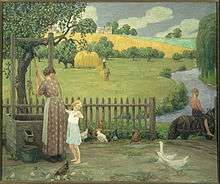Bryson Burroughs
Bryson Burroughs (1869–1934) was an American artist and employee of the Metropolitan Museum of Art. He began there as an assistant to Curator of Paintings Roger Fry, and when Fry left in 1909, Burroughs assumed the role.[1] His purchase of View of the Domaine Saint-Joseph for the museum became the first of Paul Cezanne's paintings to enter a public collection.[1][2] He also purchased the Crucifixion and Last Judgement diptych and The Harvesters for the Met.[1]

Early life
Bryson Burroughs was born in 1869 in Hyde Park, Massachusetts; then an independent suburb of Boston.[3] He grew up in Cincinnati, Ohio.[1] After high school, he began to pursue painting, and attended the Art Students League of New York and won a scholarship to learn in academies in Paris. There he worked under Luc-Olivier Merson and met noted painter Pierre Puvis de Chavannes and would bring him his work for advice.[3][1]
In 1895, Burroughs and his wife lived for several months in Florence, Italy. In 1909, he became the Curator of Paintings of the Metropolitan Museum of Art.[3]
Personal life
In England in 1893, Burroughs married the sculptor Edith Woodman; they remained together until her death in January 1916.[3]
His daughter Betty was married to painter Reginald Marsh from 1923 to 1933.[4]
References
- Raynor, Vivien (March 2, 1984). "Art: Bryson Burroughs, Work Inspired By Myth". The New York Times. Retrieved November 29, 2017.
- Gelfand, Aleksandr (March 15, 2013). "This Weekend in Met History: March 17". Metropolitan Museum of Art. Retrieved November 29, 2017.
- Field, Hamilton Easter (December 15, 1919). "Bryson Burroughs: The Man and His Work". Arts & Decoration. Joseph A. Judd Publishing Company. 12 (2): 82–4. Retrieved November 30, 2017.
- Todd, Ellen Wiley (1993). The "New Woman" Revised: Painting and Gender Politics on Fourteenth Street. University of California Press. p. 51. Retrieved November 30, 2017.
| Wikimedia Commons has media related to Bryson Burroughs. |